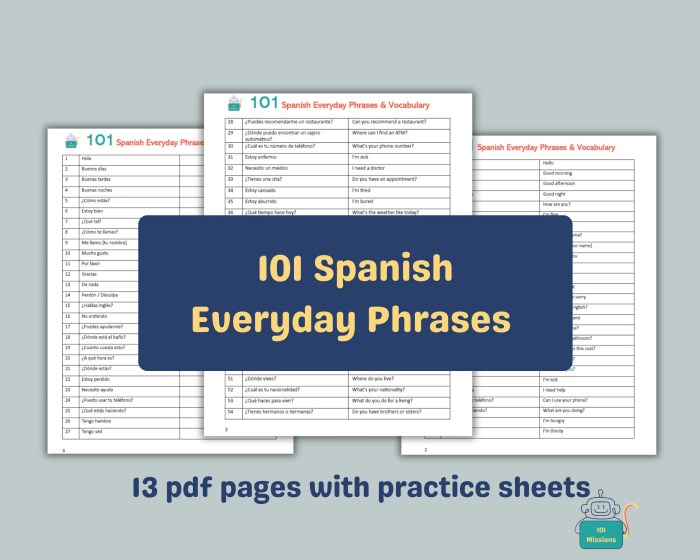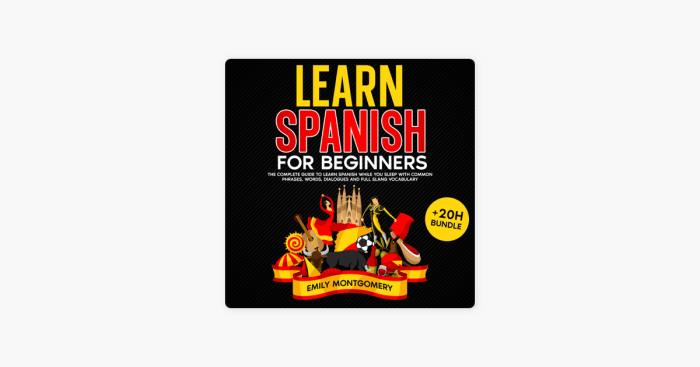How to Learn 20 Common Spanish Phrases in 1 Week takes you on a journey to mastering essential phrases quickly and efficiently. From daily practice schedules to immersive learning techniques, this guide will equip you with the tools you need to become conversational in Spanish in just one week.
Breakdown of Common Spanish Phrases

In this section, we will list out 20 common Spanish phrases, providing translations, pronunciations, and explanations for each one.
Greetings
-
Hola
Translation: Hello / Pronunciation: oh-la / Context: Used as a general greeting in both formal and informal settings.
-
¿Cómo estás?
Translation: How are you? / Pronunciation: koh-moh ehs-tahs / Context: A common way to ask someone how they are feeling.
-
Buenos días
Translation: Good morning / Pronunciation: bweh-nohs dee-ahs / Context: Used to greet someone in the morning.
-
Adiós
Translation: Goodbye / Pronunciation: ah-thyohs / Context: Used when parting ways with someone.
Common Phrases
-
Por favor
Translation: Please / Pronunciation: pohr fah-bohr / Context: Used to make a polite request.
-
Gracias
Translation: Thank you / Pronunciation: grah-thyas / Context: Expressing gratitude towards someone.
-
Lo siento
Translation: I’m sorry / Pronunciation: loh syen-toh / Context: Apologizing for a mistake or expressing sympathy.
-
De nada
Translation: You’re welcome / Pronunciation: deh nah-dah / Context: Response to “thank you” to acknowledge the gratitude.
Basic Conversational Phrases
-
¿Cómo te llamas?
Translation: What’s your name? / Pronunciation: koh-moh teh yah-mahs / Context: Asking someone for their name.
-
¿Dónde está el baño?
Translation: Where is the bathroom? / Pronunciation: dohn-deh ehs-tah ehl bahn-yoh / Context: Inquiring about the location of the restroom.
-
¿Cuánto cuesta?
Translation: How much does it cost? / Pronunciation: kwan-toh kwehs-tah / Context: Asking about the price of something.
Travel Phrases
-
¿Dónde está la estación de tren?
Translation: Where is the train station? / Pronunciation: dohn-deh ehs-tah lah ehs-tah-syon deh trehn / Context: Inquiring about the location of the train station.
-
Quisiera una habitación
Translation: I would like a room / Pronunciation: kee-syeh-rah oo-nah ah-bee-tah-syon / Context: Requesting a room in a hotel.
-
¿A qué hora es el vuelo?
Translation: What time is the flight? / Pronunciation: ah keh oh-rah ehs ehl bweh-loh / Context: Asking about the departure time of a flight.
Food and Dining Phrases
-
La cuenta, por favor
Translation: The check, please / Pronunciation: lah kwehn-tah, pohr fah-bohr / Context: Requesting the bill at a restaurant.
-
¿Qué recomienda?
Translation: What do you recommend? / Pronunciation: keh reh-koh-myen-dah / Context: Asking for a recommendation from a waiter.
-
Está delicioso
Translation: It’s delicious / Pronunciation: ehs-tah deh-lee-syo-so / Context: Expressing enjoyment of the food.
Daily Practice Schedule

To effectively learn 20 common Spanish phrases in just one week, it is crucial to establish a daily practice schedule that includes dedicated time slots for practice sessions. By following a structured routine, you can reinforce your learning and improve retention. Here is a suggested daily schedule:
Morning Practice Session
- Start your day by reviewing the phrases learned the previous day.
- Engage in a short listening exercise to familiarize yourself with the pronunciation.
- Create flashcards with the phrases and their translations for quick recall.
Afternoon Practice Session
- Practice speaking the phrases out loud to work on your pronunciation.
- Utilize mnemonic devices to help remember the meanings of the phrases.
- Engage in simple conversations using the phrases to reinforce their usage.
Evening Review Session
- Review all 20 phrases before bedtime to solidify your memory.
- Test yourself with a quick quiz or writing exercise to assess your progress.
- Reflect on any phrases that were challenging and focus on them the next day.
Immersive Learning Techniques: How To Learn 20 Common Spanish Phrases In 1 Week
To immerse yourself in the Spanish language and speed up your learning process, there are various techniques you can use. One effective method is to surround yourself with Spanish media, such as movies, TV shows, or music. This exposure will help you get accustomed to the sounds and rhythm of the language.
Watching Spanish Movies or Listening to Spanish Music
Watching Spanish movies or listening to Spanish music is a great way to immerse yourself in the language. Pay attention to the dialogues, lyrics, and pronunciation. You can also try watching with subtitles in Spanish to help you understand the context better. Some recommendations for Spanish movies include “Pan’s Labyrinth” and “Y Tu Mamá También.”
Practicing Speaking with Native Speakers or Language Exchange Partners
Another effective way to immerse yourself in the Spanish language is to practice speaking with native speakers or language exchange partners. This will not only improve your speaking skills but also help you gain confidence in using the language. Look for language exchange groups online or in your community to find partners to practice with. Remember, practice makes perfect!
Memory Tricks and Techniques

When it comes to learning and retaining new Spanish phrases, memory tricks and techniques can be incredibly helpful. By incorporating mnemonic devices, visualization methods, and the creation of associations or stories, you can enhance your ability to remember the phrases more easily.
Mnemonic Devices
One effective memory trick is to use mnemonic devices, which are techniques that help you remember information through associations. For example, creating an acronym using the first letter of each word in a phrase can make it easier to recall. For the Spanish phrase “¿Cómo estás?” meaning “How are you?” you could create the acronym “CE” for easier memorization.
Visualization Methods
Another technique is to visualize the meaning of the phrase in your mind. For instance, when learning the phrase “Buenos días” for “Good morning,” visualize a bright and sunny morning scene to connect the words with their meaning. This visual association can strengthen your memory retention.
Creating Associations or Stories, How to Learn 20 Common Spanish Phrases in 1 Week
Creating associations or stories around the phrases can also aid in retention. For instance, for the phrase “Mucho gusto” meaning “Nice to meet you,” you could associate it with a memorable encounter where you felt great pleasure meeting someone. By linking the phrase to a personal experience or story, you are more likely to remember it in the future.
Conclusive Thoughts
Mastering these 20 common Spanish phrases in just one week is an achievable goal with the right strategies and dedication. Start your language learning journey today and see how quickly you can progress.